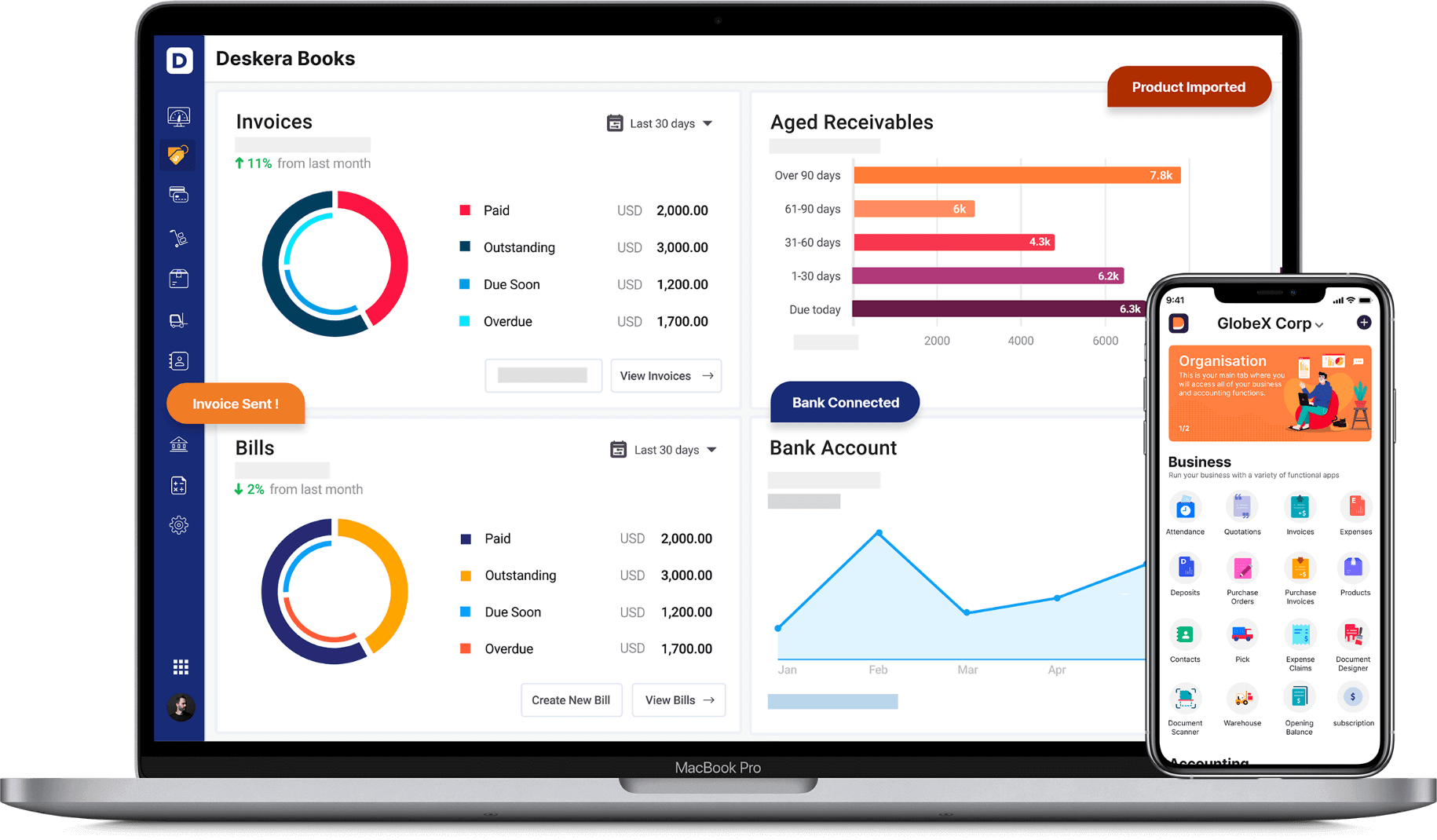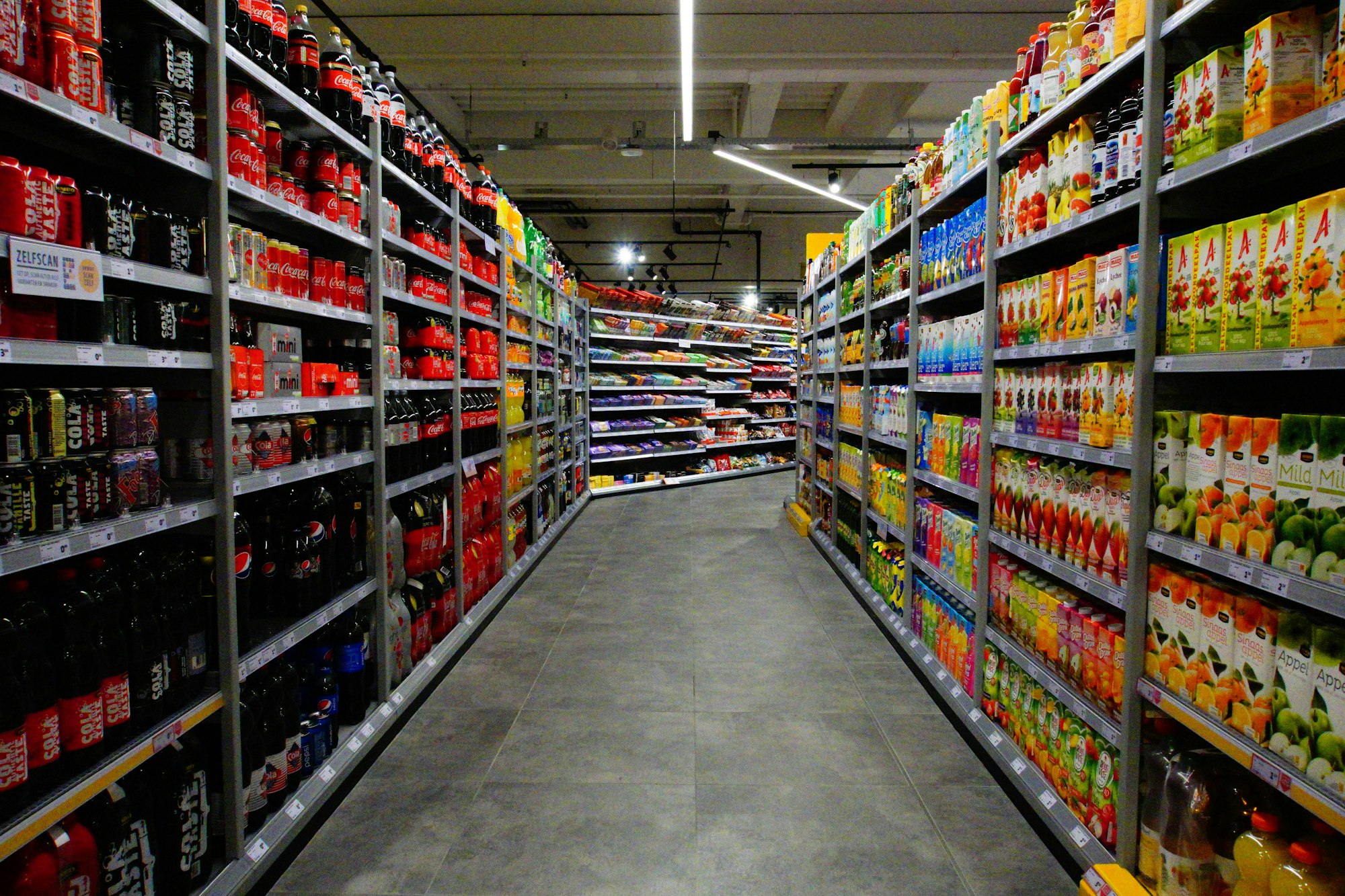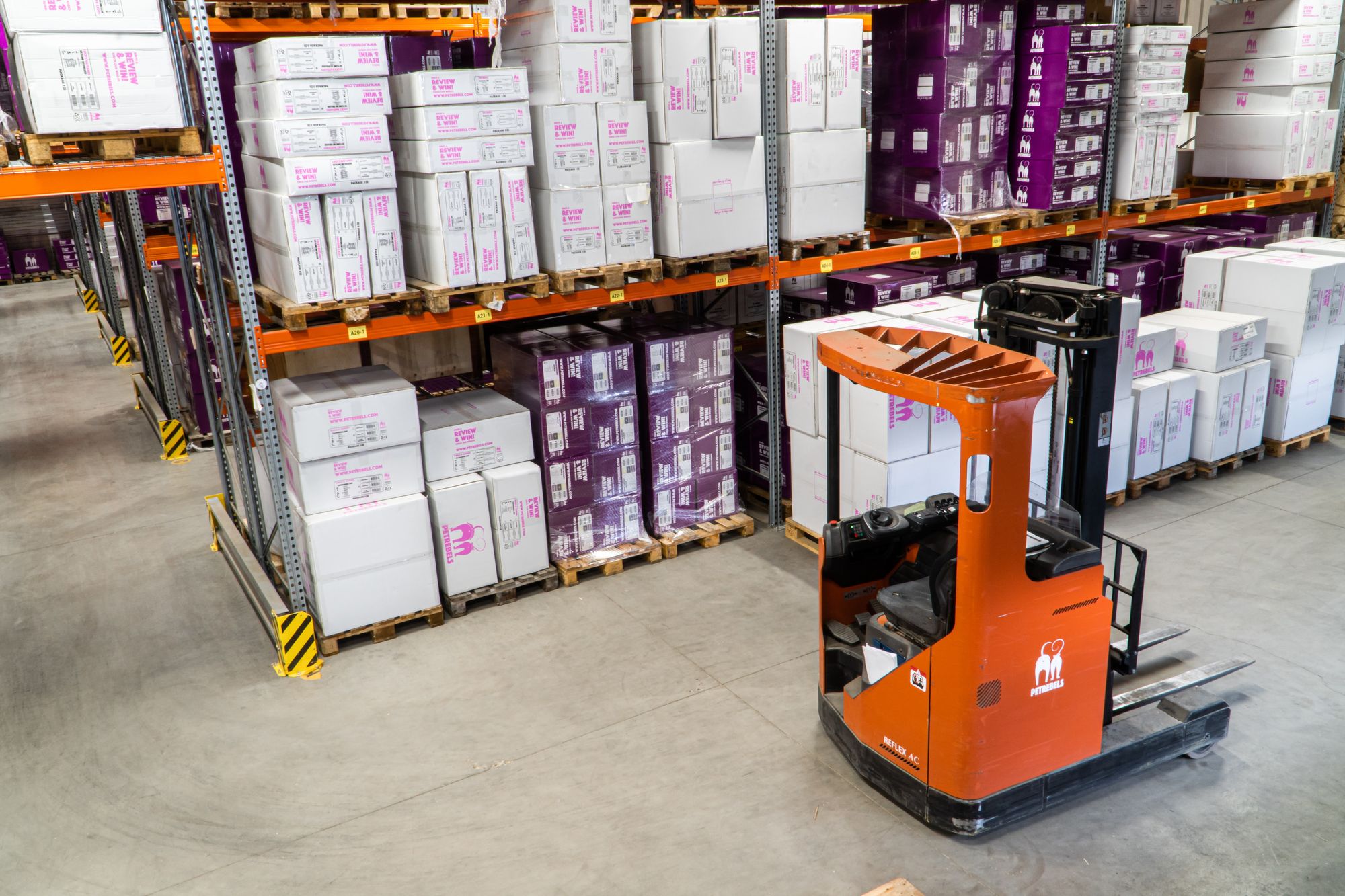Warehouse space in the USA costs about $5.08 per square foot. Additionally, American retailers carry about $1.43 in inventory for every $1 of sales. In fact, inventory accounts receivable and accounts payable amount to $1.1 trillion in assets, which is around 7% of the USA GDP.
While these statistics highlight how crucial inventory management is for a company to run its business, earn revenue, have a high net profit ratio, and have improved customer retention, the next set of statistics will highlight the risks an improper inventory management system carries for the company.

In 46% of warehouses, the topmost issue is human error, with 75% of all supply chain management professionals wanting to improve their inventory management practices. In fact, 74% of businesses have experienced delays, not only delays in shipments but also much longer lead times. In the USA, the cost of inventory distortion amounted to $1.8 trillion in 2020.
With an efficient inventory management system, however, reducing situations like stock-outs and overstocks can lower inventory costs by around 10%. This percentage highlights the perfect solution to inventory management issues that have led 72% of retailers planning to reinvent their supply chain with real-time visibility enabled by automation, sensors, and analytics.
Thus, there is now a larger focus as well as preference for effective inventory management methods that can reduce the operating costs of one’s business dramatically, increasing the gross profit, improving cash flow, and also increasing customer satisfaction.
Batch tracking is one of those inventory management practices through which your business will be able to trace and monitor the history of a group of items with similar properties. Your business will be able to do so even as those items make their way through production and distribution channels, all the way to customers.
This, when implemented through an ERP system, will sort a large chunk of your challenges related to inventory management. This article will thus be your perfect guide for batch tracking of inventory as it covers the following topics:
- What is Batch Tracking of Inventory?
- Why is Batch Tracking Important to Businesses?
- Who Needs to Use Batch Tracking?
- Benefits of Batch Tracking
- Inventory Batch Tracking Strategies
- Best Practices for Batch Tracking
- How to Set Up Batch Numbers?
- What is a Batch Tracking Software or Batch Inventory Management System?
- Using Batch Management in Manufacturing
- Batch Tracking FAQs
- How Can Deskera Help You with Batch Tracking of Inventory?
- Key Takeaways
- Related Articles
What is Batch Tracking of Inventory?
Batch tracking is a practice that is used in inventory management to group items with similar production characteristics like manufacturing date and location, expiration date, and usage of specific parts and raw materials, as well as supply chain sources. Batch tracking is also known as lot tracking.
Batch tracking thus makes it possible to trace and monitor groups of items with similar properties as they make their way through production and distribution channels, all the way to consumers. This helps in improving the accuracy of inventory while also facilitating faster tracking of specific batches or items even after they are sold. Additionally, it also supports various delivery sequencing strategies like:
- First In, First Out (FIFO)
- Last In, First Out (LIFO)
- First Expiring, First Out (FEFO)
And so on.
In fact, in case of quality issues, batch tracking also helps in identifying the source of the problem and also in locating other items that share the same quality issue. Batch tracking also contributes to the ability to efficiently and smoothly recall defective or potentially hazardous items.
The basic assumption that is kept in mind during batch tracking of inventory is that the items in the inventory were not produced individually. In fact, batch tracking is a step up from basic stock tracking, in which all of the same product or material available in inventory is aggregated, with each item receiving a stock keeping unit (SKU) number for individual tracking.
In batch tracking, considering that it gathers items with similar properties in a single group, products not only get an SKU number but also a lot or batch number. This means that when you use batch tracking, you can log precise details about your sellable items like:
- Materials used
- Assembly location
- The date on which products were received
- Expiration date
And so on.
All this information is traceable through the batch number and, with good record-keeping, can be accessed even when the product is in possession of your customers. Thus, when products are registered by their owners, batch information combined with registration information can greatly simplify communications if defects or recalls arise down the road.
Why is Batch Tracking Important to Businesses?
Batch tracking is one of the best ways to solve inventory management challenges. The solution that is offered by batch tracking in solving these challenges lies in the information that it delivers in the form of the ability to track the manufacturing characteristics and component sources of products in the inventory of your business. Additionally, batch tracking will also let you track the subsequent distribution of your finished products.
The importance of the same can be explained further through this example:
One of your customers receives a defective item and contacts your company requesting an exchange or refund. Now, with batch tracking, you would be able to easily track down where the product was sourced from, or where it was manufactured, and what materials were used to make it.
Once you have these details, the remaining products from the same batch can be checked for quality control, making it possible for you to remove any defective or expired products from circulation before they reach your other customers.
Furthermore, you would be able to analyze all such refund or exchange requests to determine return rates on specific batches, and if you find a bad batch, then further analysis of the same will help you in identifying the source of the problem, thereby preventing more faulty products from being manufactured.
In fact, the customer support of your company will also benefit from batch tracking as knowing detailed information about an item’s lot will help them in answering customers’ queries, also ensuring proactive customer service in the process. This is also because knowing that a product in question comes from an inadequate batch will speed up the return/refund process, making the experience less stressful for your customers as well as you.
Such measures undertaken by you will have a long-term impact in the form of improved cash flow, a higher number of returning customers as well as customer retention, a strong and positive brand image, and a higher gross profit ratio.
Also, the example illustrated above highlights how batch tracking is especially important for businesses that sell perishable items as it supports multiple inventory-sequencing strategies, the most popular of which are LIFO, FIFO, and FEFO.
Who Needs to Use Batch Tracking?
While most businesses associated with manufacturing, distribution, and retail inventory operations will benefit from batch tracking, it is not a requirement for all businesses. Batch tracking is especially indispensable for some industries because of safety and compliance purposes. This includes, but is not limited to:
Food and Beverage Industry
Batch tracking is an indispensable inventory management practice in the food and beverage industry because even non-perishable food items like canned goods and other shelf-stable foods have an expiration date. While some of these might still be safe for consumption, they definitely should not be sold after their “best by” date in order to comply with the regulations of the governing authorities, as well as to ensure the health and safety of your customers.
In fact, in the case of perishable items like fresh meat, dairy, vegetables, and fruits, they have stricter rules to comply with, making the companies associated with them rely on batch tracking to ensure not only compliance with those regulations but also to ensure customer safety.
Similar to the food industry, beverage manufacturers and distributors also need to track batches of their products to monitor expiration dates or to pull out contaminated batches from the market. This is why the implementation of ERP in the food and beverage industry is crucial.
For example: In mid-2021, an outbreak of Listeria Monocytogenes forced nearly 9 pounds of chicken to be traced and recalled. Due to batch tracking, the US Department of Agriculture’s Food Safety and Inspection Service (FSIS) was able to successfully cross-check the information collected from all the sick individuals with the recorded data from the batches of cooked chicken.
They were then able to identify the exact lots that were contaminated and needed to be pulled out of the market, as well as the facilities in which they were produced. This saved other customers from potential harm and helped the company get back into compliance faster, then also being able to return to selling safe chicken.
Health and Wellness
Personal Protective Equipment (PPE), medicines, cosmetic products, supplements, and wellness gadgets all have a set of compliance rules that they must follow as they are directly associated with the health and wellness of their consumers.
This also applies to all the color additives added to the cosmetics, which need to be approved by the US Food and Drug Administration (FDA), for example. The benefit of batch tracking is that it ensures compliance of each batch before individual items of that batch reach your customers.
Additionally, if a batch of your products needs to be recalled, and this particular batch needs to be tracked down due to potential risks associated with them, batch tracking that keeps track of all the details of your products from its production to its distribution and even after sales, will make this not only possible but also easy to achieve.
For example, in 2018, a company voluntarily recalled more than five lots of a cleansing foam after the FDA determined through batch tracking which batches were contaminated with Burkholderia cepacia complex, which can cause serious respiratory illness.
It is because of all these reasons that batch tracking is essential for all the following through:
- ERP implementation for FMCG Industry
- ERP implementation for Medical Supplies Industry
- ERP implementation for Hospitals
- ERP for Healthcare Sector
Organic Material-Derived Products
Usually, an expiration date is required if an organic raw material is used in the manufacturing of a product. For example, the manufacturing of paint pigments and natural rubber. In such cases, batch tracking is used to monitor the expiration dates and prevent the sale of aging stock.
For example, oil-based paints contain high levels of organic compounds that limit their shelf-life to around two years. Thus, considering this, batch tracking is vital in the chemical industry, making ERP implementation in the chemical industry equally vital.
Electronics and Automotive Industry
Considering that with the help of batch tracking, thorough traceability of products is unlocked, it makes it a useful inventory management practice for the electronic industry as well. In this industry, safety and quality control are usually the main concerns, which might also lead to the recalling of defective batches of products and the replacement of certain parts in specific batches of vehicles so that they do not need to be pulled off the market.
Thus, with batch tracking, a company in the electronics industry will be able to proactively trace and pull potentially risky products from the market, also letting that company to alert any of its customers who bought items from its inadequate lot.
This is why ERP implementation in the electronic goods industry, as well as ERP implementation in the automobile industry, is the best way to have an efficient and easy way of enabling batch tracking in the companies of these industries.
Benefits of Batch Tracking
All the main benefits of batch tracking arise from its main benefit, which is that it makes end-to-end traceability possible. Thus, when your business can monitor the quality and shelf-life of your products all the way from raw materials to post-sales, you unlock the following array of benefits and more:
Safety and Compliance
Batch tracking is the central key in monitoring your inventory for safety and quality control because when problems are found, all the items in a related lot can quickly and efficiently be pinpointed, enabling you to solve the problem immediately. This ensures the safety of your consumers, as well as that you are complying with the standards laid down by the regulatory authorities.
In fact, with batch tracking, full traceability of your product through its product life cycle and in its respective batches is kept track of, letting you identify the root of quality issues based on source, batch, or transport path in a quick yet efficient manner.
Additionally, considering that in industries like pharmaceuticals, and food and beverage, the regulatory bodies have set extremely rigid guidelines with regards to distribution, storage, sales, and supply, which you are obliged to follow.
Batch tracking not only makes this possible but also makes it easier to incorporate, letting you stay on top of all such compliances by tracking and recording end-to-end supply and distribution.
Tracking of Expiration Date
Considering that your products will be made in batches and that each batch will have the same expiration date, batch tracking makes it simpler to track the expiration dates of your products.
The data of expiration dates will then be used in delivery sequencing strategies, as well as for marketing and promotions. This is because if the expiration date of a certain batch is nearing, and the sales are not frequent enough for those products to be sold on time, you would be able to use marketing strategies and promotions in the manner that you attract your buyer personas, and persuade them to purchase your product.
Thus, with batch tracking, you would be able to keep a check on your expenses and operation costs while having a higher ratio of accounts receivable to accounts payable.
Automated Inventory Sequencing
If you incorporate batch tracking in your business, you can set up automated inventory sequencing strategies like FEFO or FIFO. This will maximize the value of your inventory by minimizing potential waste, thereby improving your financial KPIs and other relevant business metrics and operational metrics.
Smoother Recall Processes
For long-term customer satisfaction, as well as strong customer loyalty, it is essential that when required, you are able to quickly and efficiently pull products off the market, thereby preventing bigger issues and greater damages. When such a need for recall emerges in your business, your batch tracking software will be able to help you send appropriate messages to your supply chain and affected customers more quickly.
Thus, by being able to handle a recall effectively, you would be able to get an opportunity to turn a negative scenario into an opportunity that encourages loyalty and positive brand awareness.
Improved Product Quality
With batch tracking of your inventory from raw materials to post-sales, and through your analysis as well as customer feedback, you would be able to figure out which materials went into a superior batch of products, thereby letting you figure out your best suppliers.
You can then keep on ordering from those best suppliers while simultaneously staying away from those who have supplied you with inadequate materials. This will result in better quality products overall, improvement in customer satisfaction, maintenance of your brand image, and boosting of your net revenue which will be positively reflected in your financial statements.
Better Supply Chain
The same ability to identify superior batches that leads to improved product quality also has the ability to improve your supply chains. Batch tracking will help you identify and transact more business with the best and most cost-efficient vendors, which will not only increase your net income but also customer satisfaction. In fact, the benefits from the same will be clearly reflected in the key performance indicators relevant to your business.
Cost Reduction
With batch tracking and all the information, visibility as well as insights that it gives, making better-informed decisions becomes possible, thereby saving the money of your business.
For example, due to batch tracking, you would come to know the best time to sell a batch of products based on their shelf life, thereby helping you avoid stock aging beyond its sellable date and all the losses that might have followed otherwise.
Similarly, through batch tracking, you would also come to know in good time when you need to recall a certain batch of products, thereby letting you save on replacement shipping fees and potential legal costs. In fact, in detecting a batch that needs to be recalled and vendors that need to be communicated to, batch tracking is efficient and quick.
Fewer Accounting Mistakes
Batch tracking will make it possible for you to have automated processes, which will help in reducing accounting mistakes or misinterpretations of data. Additionally, improved visibility, as given by batch tracking, will also make it easier for you to monitor the location of all items in your batch, letting you determine whether they are still in inventory, in transit, or already sold.
Clear Communications Throughout the Process
With batch tracking that is as per industry standards, like in the case of those provided by ERP systems, you would be able to ensure that everyone in your organization is updated in real-time.
Considering that a quality system is designed to integrate with everything from backend order picking to front-end eCommerce sales, every part of your business operation will get updated with the latest information in real time. This is great news for the sales team because:
- It will let your sales team identify the older products that they can sell first, hence letting them avoid a situation where your company incurs the costs of discounting short-dated products, as well as loss due to spoilage of perishables.
- Being able to avoid the spoilage of perishable products will secure higher profits for you, especially if your sales team takes the required actions quickly, in the process improving your profit and loss statement.
- Clear and up-to-date information will help you, as well as the relevant departments in your organization, in ensuring that the products are flowing through your business as they should.
Increases Efficiency
Considering that batch tracking will give you a real-time view of your entire inventory, you would not have to waste time wandering through your fulfillment center to find out where you have put an item from a specific batch or product component.
For example, you received a toolbox with 100 pieces from your supplier, and you put it in your warehouse. Now, with batch tracking, you would be able to easily find all of its components in the warehouse by looking into your inventory data.
Thus, with batch tracking, you would get greater control over your inbound and outbound processes, thereby helping you in increasing the efficiency of your business processes.
Eliminates Human Error
With batch tracking, the need to manually track your inventory gets eliminated, thereby ensuring that common picking mistakes such as shipping out an incorrect product component can be avoided. This thus helps in improving order accuracy, saving you additional time, expenses, and even the risk of bad credit.
Helps in Managing Warranties
There are certain products, like electronic goods, which come with a manufacturer’s warranty. To be able to have real-time yet accurate and easily accessible records of the same, having an up-to-date warranty management system is a must.
Batch tracking is the answer here, as it will help you keep track of such warranties according to serial numbers, time frames, condition of goods, and manufacture dates.
Facilitates Advanced Reporting
By providing real-time and accurate data like customized batch-specific reports from your warehouse, batch tracking facilitates advanced reporting for you. For example, with batch tracking of inventory, you would be able to easily identify which batch of your inventory is causing more returns and not meeting the needs of your customers.
Additionally, batch tracking also allows you to conduct inventory audits and warehouse audits more efficiently, thereby also ensuring that you are accurately complying with all the applicable regulations and guidelines on a timely basis.
Inventory Batch Tracking Strategies
Inventory batch tracking strategies are also known as delivery or fulfillment sequencing. The most common inventory management strategies are enabled by batch tracking are FIFO, LIFO, and FEFO.
The usual rule of thumb for these strategies is that FIFO is used for fast-moving products, FEFO is used for perishables, and LIFO is used when the storage structure does not allow access to the older products. These three batch tracking strategies are most widely known and used, but there are also other strategies that bring out additional factors into consideration.
For example, FEMAL (prefer first expiry, minimum available lifetime) does move products based on expiration date like FEFO, but, for all those products with similar expirations, it chooses those with the strongest remaining useful life first. However, this is done only as long as the remaining useful life in question is greater than a calculated minimum “margin of expiration.”
In the case of the FESAL (first expiry, shortest ambient lifetime) approach, the changes in temperature, which can shorten the useful life of your product, are considered, and their sales are scheduled accordingly. Your products can also be sequenced via LOFO (lowest in, first out) strategy or by HIFO (highest in, first out) strategy. Both these strategies take price fluctuations into consideration.
While all of these alternative strategies are used on a rare basis and thus in extremely limited circumstances, the main steps of these strategies, however, are that with batch tracking: you monitor the expiry date and shelf life of a particular batch of your product, and then based on this knowledge, you would be able to establish automated sequencing to move your inventory, the strategies of which can be:
FIFO
According to the First In, First Out (FIFO) approach to inventory management, your oldest inventory will always be sold first. This strategy of inventory management is especially useful if your company is involved in selling fast-moving and/or food products, as it will ensure that regardless of their shelf life or expiration date, none of your products sit in your inventory for too long.
Thus, this strategy tends to become the usual default method of stock control of your business if dealing with food products and/or fast-moving products.
LIFO
Last In, First Out (LIFO) strategy of inventory management is rarely used and for those products that do not have a natural expiration date, making it possible to move the most recently produced or acquired items first. However, this strategy is used the most only when there is no way or when there is no easier way to access the older items without first moving the new products.
For example, stackable items like boxed goods or construction blocks, products sold in bulk and stored in piles like sand and cement, products stored in cellars or containers accessible only from one side, etc.
However, what needs to be especially noted here is that while LIFO can be used in the US, it is banned under International Financial Reporting Standards (IFRS).
FEFO
First Expiring, First Out (FEFO) is an inventory management approach that can be used by you if you have products with a clear expiration date. As per this approach, all your products with the expiration date closest to the purchase date are sold, consumed, or otherwise disposed of first, irrespective of when they were produced or acquired.
In fact, for perishable goods like meats, fresh fruits, and dairy products, FEFO is preferred over FIFO. This is because production date and expiration date do not always go hand and hand because, for example, the freshness of certain ingredients may result in the expiration date of the second batch being before that of the batch that was produced earlier.
For example, if you make hummus, and in this week’s production of the same, you used older chickpeas, but in the batch made last week, you used fresher ingredients, it would mean that the expiration date of this week’s batch should be before the expiration date of the previous week’s batch. If in such a situation, FIFO was used instead of FEFO, the hummus with the shorter shelf life would end up sitting longer in your storage, potentially aging past its sellable date.
Best Practices for Batch Tracking
Considering that batch tracking can improve your inventory management as well as order fulfillment, implementing it and software that would support it will be a boon for your business. Some of the best practices of batch tracking that you should definitely incorporate are:
Fulfill Orders at Batch Level
If your business is product-oriented, then it is vital that you find the best way to efficiently manage your inventory. This is because the strategy that you opt for in your inventory management will have profound effects on your profitability and, therefore, the success of your business. FIFO, LIFO, and FEFO as discussed above are some of the most common and preferred inventory management strategies.
Thus, to fulfill orders at the batch level, and for example, if your product is fresh fruit juice, then you would opt for the FEFO strategy, according to which the product with the closest expiry date will move out first. Now consider that your inventory consists of three batches based on their respective expiry dates:
Batch A: Expiry date is January 2023
Batch B: Expiry date is July 2023
Batch C: Expiry date is December 2022
Thus, under the FEFO strategy of inventory management, when you receive orders for this particular product, you would first ship out Batch C as its expiry is closest. This will help you in keeping your customers satisfied, comply with the standards laid down by the regulatory authorities, and keep your expenses in check and your profitability on the rise.
Use a Barcode Scanning System
One of the best ways of reducing manual work and simultaneously eliminating human error is by tagging every batch with a barcode using an inventory scanner system. This practice will also help you avoid time wastage as you would not be required to manually input data for each of your batches.
Having an automated database of your inventory will also help streamline and integrate your operations. Moreover, you would also be able to save on labor costs, increase the productivity and profitability of your business operations, and speed up the entire order fulfillment process, thereby giving encouragement for your customers to return.
Leverage a Distributed Network of Fulfillment Centers
After batch tracking, you can split your inventory across your multiple fulfillment centers, the locations of which would either be such that it costs less, reducing the brunt on either working capital or on business capital, or such that it is closer to your target customer groups, speeding up the orders fulfillment process, while also reducing transportation costs.
In either case, you would be able to offer more competitive pricing to your customers, thereby increasing customer retention as well as increasing your sales. Additionally, multiple fulfillment centers would be especially useful if you deal in food and beverage products that expire soon, like muffins, juices, etc. Multiple fulfillment centers will enable you to save on crucial time.
How to Set Up Batch Numbers?
Batch numbers or lot numbers are unique codes that are used to identify a collection of specific products. This makes it very different from the SKU as it identifies individual products in your inventory, whereas the batch number is assigned to all products that share a similarity like an expiration date, source of raw materials, grade of materials used, etc.
Batch numbers ease up several functions of a business, including but not limited to recalling a batch of products from the market in case an issue arises. Setting up batch numbers will thus end up being a blessing for your business.
Aside from the need to be unique, there are no other firm rules when it comes to determining batch numbers. This means that in your batch numbers, you can incorporate as much or as little information as you deem appropriate. However, some of the key considerations for assigning batch numbers are:
Assign a Number
The only way your business will be able to accurately trace a specific batch is by assigning unique numbers to each batch. Therefore, the main requirement when setting your batch numbers is to ensure that no numbers of different batches are getting duplicated.
Another requirement is to also ensure that the code can be understood by all the relevant people within your company because only then will they be able to avail all the benefits of batch tracking.
Include Manufacturing Date
If yours is a business where production dates are very important, then you can incorporate these dates into your batch numbers so that your employees and workers will be able to identify how old a product is just by glancing at the code.
Consider Including Expiration Date
For several industries, expiration dates are very important as they can determine whether the product is saleable or not and whether it is also complying with the standard regulations or not. Thus, if your business falls into such industries, then you should also consider adding expiration dates to your batch numbers.
Consider Other Characteristics
In your batch number, you can also consider embedding other information such as materials used, color, preservatives used, etc.
Keep a Detailed Description
For each of your unique batch numbers, your inventory management system should maintain an accurate record of all the appropriate information about the suppliers, materials, and locations related to each batch. In fact, it should also have real-time updated information on which of your customers have products from a particular batch. This will create as well as ensure end-to-end traceability.
What is a Batch Tracking Software or Batch Inventory Management System?
A batch tracking software or batch inventory management system is an automated tool that will help you to group your products as per their shared characteristics, letting you trace them throughout their production cycle till post-sales.
Thus, making such software and systems essential for those discrete manufacturing and businesses that handle perishable goods, goods that expire, electronic goods that tend to have manufacturing warranties, or products that can go out of vogue.
A batch tracking software or batch inventory management system will help in:
- Tracking the expiry date of your products, thereby allowing the implementation of efficient inventory management, decreasing your spoilage, and boosting your profitability.
- Tracking defective products to the batch that it was produced in. Once you have discovered faulty products, with a batch tracking system, you would be able to trace them back to the relevant batch, hence effectively reducing the risk of defective products being released in the market, thereby protecting not only your goodwill and customer base but also your revenue.
- Tracing defective items back to their respective batches letting you take the required corrective actions that will mitigate the loss due to the same.
- Tracing your defective products will lead to better transparency with your own departments, as well as customers. Additionally, it will also lead to faster and easier compliance for your business.
- Performing effective product recall when required, as with a batch tracking system, you would be able to easily track the locations of all your products.
- Compliance with industry legislation and regulations is made possible with batch tracking, keeping you in good standing with the regulatory authorities while also saving you from penalties.
Using Batch Management in Manufacturing
Now that we have already discussed what batch tracking is and how it can be achieved easily with proper software like Deskera ERP, let’s discuss how you can implement batch management in your manufacturing.
Assigning Batch Numbers
Batch or lot numbers will help you in tracing items in the production process. This means that with batch or lot numbers, you can track end-to-end components, raw materials, supply chain, manufacturing process, delivery to customers, and even up to the service stages.
However, what you need to keep in mind is that batch numbers are complex, thus requiring you to have a proper system that will simplify the whole process of assigning the batch numbers and tracking them. If done manually, this process becomes very chaotic as well as prone to human error.
Thus, assigning of batch numbers and then managing batches through software will work as follows:
- Every product type will be defined as an inventory item
- This will then be allocated an inventory level
- Real-time inventory levels will be tracked to check the product stock in warehouses
- Inventory levels will then be further divided into batches, and respective batch numbers will be assigned to them.
- Your inventory batches will get updated in real-time.
- The inventory levels in respective batches will shift when the inventory comes in or goes out.
Thus, assigning batch numbers will also help in quickly and effectively replying to complaints about the product from the customers and also if you need to recall a particular batch of your products.
Centralizing Your Business
The best way to have a productive and profitable manufacturing process is by having smart manufacturing, which involves creating an ecosystem that connects your tools and machinery via the internet. This will prove to be essential in learning how to track production in manufacturing.
A robust ERP solution like Deskera comes with features of batch tracking and manufacturing modules that offer the following benefits, thereby centralizing your business and paving the path to success:
- Predictive maintenance
- Cost reduction
- Automated data collection
- Smoother workflows
- Integrations
- Barcode scanning capabilities
Connecting Sales Orders to Production Flow
Connecting your sales order to your production flow through an ERP system will significantly improve your batch tracking as now you would be able to check whether your finished goods batches are adequate to fulfill your sales orders or not.
With such integrated data tracking and analysis, you would come to know immediately when you are running low on finished products and when you do not have enough raw materials in your inventory to manufacture the finished products.
Once you have all such insights, you will be able to take relevant measures, ensuring that your sales remain continuous, your customers' demands are fulfilled, and that you have a healthy cash flow with high profitability. For instance, if you have low stock of certain raw materials, you can order them immediately from your vendor to have them on time for their production cycle.
Thus, when your production, sales, and inventory are integrated, you would be not only able to plan and schedule your production much better but also be able to avoid situations of overstocking or under-stocking, expiration of your products, and higher operating expenses over operating incomes.
Lean Manufacturing
The lean inventory approach in your manufacturing will help you optimize not only your inventory stage but also your overall business management. This is because lean manufacturing will:
- Minimize wastage from your processes
- Remove unnecessary steps from your processes
- Remove scrap and leftovers from your processes
While you can implement lean manufacturing and streamline tracking without a batch tracking system, but in that case, you would not be able to do it proactively, making your actions only reactive, which will reduce its effectiveness.
Without a batch tracking system in place, you would not have access to production analytics and actionable insights, which will make your actions proactive and more effective.
Thus, with a combination of lean manufacturing in your batch tracking system, you would be able to make your manufacturing process greener, be able to recognize production bottlenecks well on time and even in advance and be able to carry out proactive maintenance.
Prioritize
With all the insights from batch tracking, you would be able to refine your production schedules based on real-time information, which will significantly improve the effectiveness of your production tracking, as well as profitability.
By optimizing your production schedule, you would now be able to go as per your plan, in order to handle predicted demand and be able to drastically reduce your manufacturing lead time.
In contrast, if you do the same processes manually, you will have to invest a lot of time and resources, and yet it will have to be updated frequently. For example, if some obstacle has delayed or changed your production in any way, then in the case of manual data entry, you would have no way of accounting for it.
Also, manually carrying this out will make it inflexible while also bearing the risk of damaging your reputation due to human error, the absence of real-time information, and faulty prioritization and decision-making.
In contrast, batch tracking and management software will facilitate process automation for you, easily redesigning the schedules if required. This will enhance your production considerably while also safeguarding your reputation, customer base, profits, and income.
Batch Tracking FAQs
- How do I track a batch number?
With inventory management software like Deskera Books, batch numbers are easily traceable. Using batch numbers (also known as lot numbers), your inventory management software will let you back-trace, forward-trace, and continuously monitor items from manufacturing to sale, according to their specific batch.
- What is a batch number used for?
Batch numbers are used for identifying and monitoring a batch or a lot of products that share similar production characteristics. Batch numbers are thus also used for tracking defective products so that you can then investigate the source of a problem or the recall process gets simplified for you. Batch numbers are also used for improving inventory movement efficiently through fulfillment sequence strategies.
- What is the batch number of a product?
The batch number of a product is the number or code assigned to it in your business’s inventory. Batch number is thus used to track all the items that share similar characteristics of production (date, time, location, materials used, etc.).
- What is batch traceability?
Batch traceability is an important part of inventory management. It is the ability to trace the “genealogy” of a product- including the raw materials used to produce it, the equipment it was manufactured on, the results of quality inspections and its serial numbers, as well as the product’s progress through the distribution channels from manufacturing to customer sale. Batch traceability is made possible by batch numbers, and the main objective of batch traceability is quality control and safety compliance.
How Can Deskera Help You with Batch Tracking of Inventory?
Deskera Books is part of the Deskera ERP system that has all the features to automate your accounting, invoicing, and inventory-related tasks. The benefit of this is that you would be able to make your customers happy with professional invoicing, faster order fulfillment, and online payment options.

Additionally, with Deskera Books, you would be able to easily perform advanced inventory management operations with serial and batch tracking, bill of operations, and more. In fact, you would even be able to forecast your inventory requirements by getting insights from built-in inventory and stock reports.
Not only this, but you would also be able to track and manage your inventory across multiple warehouses and stores using Deskera Books, which will also let you make stock adjustments, thereby helping you in optimizing your stock levels.
Lastly, to have complete traceability from raw materials to post-sales services, Deskera Books also has features that will let you automatically scan purchase invoices, bills, and expenses, so that you can add them to the system and track them. This is made possible by Deskera’s intelligent image processing capabilities that will help you identify, fetch and fill scanned document fields.
Key Takeaways
Batch tracking of inventory is thus one of those inventory management practices that offer benefits to most of the organizations in the form of increased visibility and precision in inventory management.
Additionally, it also boosts safety and quality control while also providing the means for managing different inventory sequencing strategies like FIFO, LIFO, and FEFO, which helps businesses to avoid losing stock that has become too old for sale.
In fact, because of these benefits and more, batch tracking indirectly helps businesses in maintaining or improving the satisfaction of their customers, as well as in raising their product quality. However, to reap all these benefits of batch tracking, having a software that supports it is a must.
This is where Deskera’s Books comes into the picture, which is well-equipped to assist you with batch tracking and inventory management. In fact, the mobile app of Deskera is so well designed that it will let you scan your product’s barcode in the system, automatically recording its details in the system and saving hundreds of hours of manual work.
Related Articles













